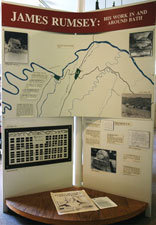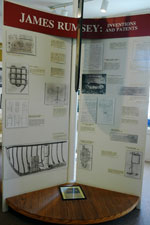Rumsey Exhibit – Manual
Panels 5 & 6 James Rumsey The Man and His Associates
(Click on images to view enlargements )
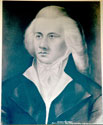
![]() Rumsey portrait: the existence of this portrait attributed to Benjamin West cannot be verified. The portrait was known to be in the collection of descendant Carroll Rumsey of Philadelphia. A photograph of the portrait was acquired by local historian Fred Newbraugh from the estate of Rumsey enthusiast Anita Buchanan Speer. Rumsey was in London at the same time as Benjamin West and was friends with one of West’s young students, George William West (no relation). Student West made a miniature of Rumsey housed today in the National Museum of American Art – Smithsonian Institute.
Rumsey portrait: the existence of this portrait attributed to Benjamin West cannot be verified. The portrait was known to be in the collection of descendant Carroll Rumsey of Philadelphia. A photograph of the portrait was acquired by local historian Fred Newbraugh from the estate of Rumsey enthusiast Anita Buchanan Speer. Rumsey was in London at the same time as Benjamin West and was friends with one of West’s young students, George William West (no relation). Student West made a miniature of Rumsey housed today in the National Museum of American Art – Smithsonian Institute.
James Rumsey – early life: Documented facts of Rumsey’s early life are few. The Rumsey family came from Wales in the 17th century to settle in Cecil County, Maryland at the northern tip of the Chesapeake Bay. The family home place was Bohemia Manor. A brick from the ruins is placed in the Rumsey Monument in Berkeley Springs State Park according to monument organizer John Moray.
The Rumsey family tree housed in the Library of Congress shows father Edward married to Anna Cowman and heading a lesser branch (in terms of family wealth) of the family.
Cecil County historians claim this Rumsey family owned and operated “an ordinary” there. A Revolutionary War record is also claimed for James by some but there are no supporting records. Examination of Rumsey’s later work and writings indicate he had little formal education. Partner Joseph Barnes demonstrated superior literary and technical engineering skills. Rumsey’s work demonstrates a working knowledge of practical mechanics, an inventive frame of mind and a knowledge of mills.
Somehow the Rumseys came to Shepherdstown, West Virginia. Brother Charles married a girl from Sleepy Creek; brother Edward began his studies for medicine there and owned land in Morgan County where James built his mill and bloomery 1782-83. (see map in exhibit and P2 of Manual.) One Rumsey sister married Joseph Barnes; another sister, Mary, married Charles Morrow of Shepherdstown. Both brothers-in-law worked with Rumsey on his many projects. Charles Morrow died only a month before Rumsey; Joseph Barnes went to England to settle Rumsey’s estate and remained in Europe for years conducting extensive correspondence with Thomas Jefferson during his presidency ultimately receiving a diplomatic appointment from him.
An 1826 letter from Henry Bedinger discovered and published in the Charleston Gazette in 1903 explains the Rumsey emigration:
“Sometime prior to the Revolution, Mr. Rumsey and family migrated from the Eastern shore of Maryland and settled in Shepherdstown; brought three sons James, Edward, Charles. James stayed with father until beginning of the war; then built at William Shepherd’s now John Line’s sawmill, a light skiff or boat in which he set out and proceeded by way of the Potomac to the Eastern shore from whence family migrated, where he married and some years thereafter but during the war, returned to Shepherdstown with his wife and family.”
Rumsey married twice and produced three children one of whom, son James, was deaf and dumb. In the 1830’s and 40’s, Rumsey relatives sought a grant for Rumsey’s children from the U.S. Congress receiving only a gold medal in recognition of Rumsey’s achievements.
Prior to Rumsey’s encounter with George Washington on September 6, 1784 in Bath (see P8 Manual), there are few public records of Rumsey. He purchased property along Sleepy Creek in 1782, sent petitions requesting boat patents from Maryland and Virginia in 1783, and advertised his Inn with Robert Throgmorton in Bath in June 1784. From the point of his boat demonstration to Washington, he becomes a public figure with more than 150 letters and documents still in existence detailing his life and work.
Joseph Barnes: one of the most important and interesting of those who aided Rumsey in his work. Barnes married a Rumsey sister. By his own description he asserted he was competent to explain Rumsey’s boat by the “circumstance of my superintending the different mechanics who worked for Mr. Rumsey.” Rumsey hired Barnes in May 1785 paying him five pounds a month until 1788. Barnes was present for the various Rumsey boat trials, and was instrumental in acquiring the necessary parts for the boat engines. Once Rumsey left for England in 1788, Barnes acted as his agent, attorney, and contractor for Rumsey design-mills. In the work with Rumsey’s mills for the Rumseian Society, letters show that Barnes’ role was to provide designs then to come and set up the mill machinery. Barnes wrote two fervent and literary pamphlets in defense of Rumsey. One: Remarks on John Fitch’s Reply to James Rumsey – July 7, 1788, defended Rumsey’s invention of the steamboat against rival John Fitch’s attack. The second: Treatise on Justice defended Rumsey’s need for a strong patent law.
In 1791, Rumsey invented a mill “on entirely new principles” and sent it to Barnes. Barnes then prepared plans and began marketing the mill. (see exhibit illustration Early Water Turbine for a sketch of the design by Barnes) There is also a handwritten essay of some complexity, unpublished, in the American Philosophical Library, by Joseph Barnes entitled an Essay on Overshot and Undershot Wheels (for mills).
A letter from the Rumseian Society to the New York State Legislature considering Rumsey patents in 1788 describe Barnes as a “very ingenious mechanic who has been employed by James Rumsey in constructing his several machines and is perfectly acquainted with all his inventions and has abilities adequate to construction of them in absence of the Inventor. He is in possession of the models and drafts necessary to show the utility of them…”
When Rumsey died in Europe in December 1792 (preceded one month earlier by brother-in-law and partner Charles Morrow) Barnes went to England to settle the estate. He was identified in British accounts as “the American engineer.” Barnes remained in Europe, received a diplomatic post from President Thomas Jefferson, a post he allegedly never actually served, and returned to the United States in 1808.
Charles Morrow was also present at the Rumsey boat trials. Rumsey entrusted care of his family to Morrow when he went to England and wrote him often. When Rumsey received some money from backers in 1791, he sent 1000 pounds in goods to Morrow in America to sell with the monies going to care for his family and to compensate Morrow for his longtime support. The Morrows were a prominent family in Shepherdstown.
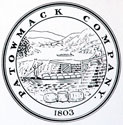
![]() Potomac Navigation Company. From his earliest years, George Washington was interested in the Potomac River for navigation to western lands. In 1772 he got the Virginia House of Burgesses to pass an act to raise money for this purpose. In 1774 and ’75 he worked to organize meetings around the issue. Finally, after the war, in 1785 Washington succeeded, Virginia and Maryland passed a compact allowing subscriptions for the navigation company. Shares were sold and a superintendent sought, preferably one with experience in canal building. When no one answered the company’s call for the job, Washington thought of James Rumsey and wrote telling him of the job on June 5, 1785. Rumsey replied immediately that he was interested believing that steady pay would help him in his boat work. Also, Rumsey seemed to believe that building and designing boats would be part of his tasks. On July 14, 1785, Washington notes in his Diary that James Rumsey was hired.
Potomac Navigation Company. From his earliest years, George Washington was interested in the Potomac River for navigation to western lands. In 1772 he got the Virginia House of Burgesses to pass an act to raise money for this purpose. In 1774 and ’75 he worked to organize meetings around the issue. Finally, after the war, in 1785 Washington succeeded, Virginia and Maryland passed a compact allowing subscriptions for the navigation company. Shares were sold and a superintendent sought, preferably one with experience in canal building. When no one answered the company’s call for the job, Washington thought of James Rumsey and wrote telling him of the job on June 5, 1785. Rumsey replied immediately that he was interested believing that steady pay would help him in his boat work. Also, Rumsey seemed to believe that building and designing boats would be part of his tasks. On July 14, 1785, Washington notes in his Diary that James Rumsey was hired.
Washington relied on “probable advantages which are expected to be derived from Rumsey’s mechanical discovery” to take boats upstream. “I have imbibed a very favorable opinion of your mechanical ability, and have no reason to distrust your fitness in other respects,” Washington wrote.
The aim of the Potomac Navigation Company was to make the upper Potomac navigable by building canals around the series of falls that prevented its easy use. For Rumsey, the job was a disaster, requiring him to exercise managerial and administrative skills he sorely lacked. Ella May Turner, in her excellent biography of Rumsey quotes extensively from his correspondence with company officials documenting the following problems: payroll money late, medicine needed, inadequate boats, difficulties purchasing supplies, insolent workers, poor supplies, providing clothes for workers, servants running away and eloping, and accidents. Letters also indicate that Rumsey spent much of his time traveling back and forth to Alexandria. Rumsey’s discontented resignation a year later led enemies to claim that he had been fired. In June 1788, Rumsey’s brother-in-law Charles Morrow wrote Washington asking him to confirm that Rumsey had quit of his own accord. Washington quickly replied that Rumsey’s leaving was “an act of his own.”
The Navigation Company ultimately went bankrupt. Rumsey capitalized on his brief tenure working on the canal while in Europe. In 1791, he earned some much needed cash overseeing work on the Irish Canal. Also during his tenure with the canal company, Rumsey invented a “lockless canal”. (see mention in exhibit and P7 of the Manual.)
RUMSEY SPEAKS.
This sequence of quotes about personal aspects of Rumsey’s life was selected to demonstrate qualities of the man.
Friendship: While in England, Rumsey was cut off from his American support group of friends and relatives. He had several disastrous encounters with bad partners and betraying acquaintances. This letter is excerpted from one written by Rumsey from London on June 30, 1790 to Levi Hollingsworth of the Rumseian Society in Philadelphia. Rumsey had recently had financial problems stemming from support of a Society member, Mr. Wynkoop, in London.
In a letter from Joseph Barnes to Charles Morrow on January 29, 1792, Barnes comments on Rumsey’s disappointments with men in London relaying information Rumsey sent him in a recent letter: “He (Rumsey) observed, that, he used to think he was more unfortunate than others, because he met with more impositions from his fellow men, but, almost too late he finds the truth to be his own credulity in, and want of a competent knowledge of mankind, which he observes, the City of London is an excellent School to teach.”
Religion: Like Washington, Jefferson, Franklin and many others of this Enlightenment period, Rumsey was probably a deist as his words on religion show. In this letter to his brother-in-law Charles Morrow on February 27, 1791, Rumsey is responding to concern about his “deficiencies” expressed by his sister, Morrow’s wife. After explaining his religious feelings in the vein indicated by the excerpt quoted, Rumsey goes on to say: “as it is really to ease her mind that I have attempted to explain some of the beauties of my Religion, and the full reliance that I have (provided I obey its dictates) on its guiding me safely to eternal rest.”
Rumsey was also attacked for his religious beliefs by Englehart Cruse, of Baltimore, who was accused by Barnes and Morrow of spying on Rumsey and stealing his steam boiler design. In 1788 Cruse wrote a pamphlet denying his role in any theft of ideas from Rumsey entitled The Projector Detected. Cruse said “it is strange that the appearance of religion should deceive you, who have none, or at least pretend to think quite differently on these subjects from the rest of mankind – for what you said to me about it amounted to a denial of those principles, which Christians of different denominations long before you and I were born, embraced and professed. But I suppose you have made some steam discoveries here too.” (see P10-11 of Manual for more about these warring pamphlets.)
Being a disappointment: this was excerpted from letter Rumsey wrote to his brother-in-law Charles Morrow August 4, 1789. Rumsey complained generally about his financial problems and their impact on his family and friends in America.
Children: Rumsey had three children, daughters Susan and Clarissa, and son James. They were cared for by the Morrows when Rumsey was in England. Rumsey asked often about them in his letters and once discussed his concern about providing money for special care for James who was reportedly deaf and dumb. In his letter Rumsey was thanking Morrow and his wife for taking care of some impropriety of his daughter’s (Susan). He then promises to write both girls and “urge a change in their conduct.” The original of this letter is in the Rumsey Papers of the Library of Congress.
Being an Inventor: The details of Rumsey’s life indicate that his destiny as an inventor was compelling, driving him to financial crisis and to leaving his family to go to England and work for the last four years of his life.
This excerpt, bemoaning the tribulations of being unappreciated for his genius, comes from his pamphlet: A Short Treatise on the Application of Steam 1788 written immediately after his successful boat trials and designed to make known his accomplishments to the world. In the pamphlet Rumsey describes the principles and mechanics of his boat in detail, outlines the processes of creating and testing it, and adds a series of depositions from people who witnessed the boat trial including General Horatio Gates, and who worked with him on the boat’s development. He concludes with a plea for public support:
“If the public thinks these inventions, which must be productive of the greatest usefulness, worthy of their patronage, I cannot fear but an exclusive right will be granted me, by the different assemblies of the United States, for a given number of years, which they may think right, for the erecting of these machines of my own invention, to compensate me for the trouble, for the time, for the expense and for the fatigue which they have cost me.” (see P9 & 10 Manual for information on the patent situation in America in Rumsey’s time.)
PANEL 6 – JAMES RUMSEY THE MAN AND HIS ASSOCIATES
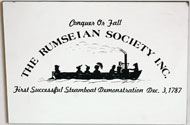
![]() Rumsey and the Rumseian Society: Once Rumsey successfully demonstrated his steamboat in public in December 1787 (seeP13 Manual) he was ready to bring his invention to the attention of the world. On January 2, 1788 he published his pamphlet: A Plan Wherein the Power of Steam is Finally Shewn describing in detail his boat and experiments with it. This same pamphlet was reprinted in May 1788 as A Short Treatise on the Application of Steam, (see P10 & 11 Manual for more information on these pamphlets). Rival inventor John Fitch was, at this time, attacking Rumsey’s claims. In order to insure priority of his claim, Rumsey felt he had to go to Philadelphia, then scientific capital of America, home of the American Philosophical Society and Benjamin Franklin. In a March 24, 1788 letter to George Washington, Rumsey explains his trip:
Rumsey and the Rumseian Society: Once Rumsey successfully demonstrated his steamboat in public in December 1787 (seeP13 Manual) he was ready to bring his invention to the attention of the world. On January 2, 1788 he published his pamphlet: A Plan Wherein the Power of Steam is Finally Shewn describing in detail his boat and experiments with it. This same pamphlet was reprinted in May 1788 as A Short Treatise on the Application of Steam, (see P10 & 11 Manual for more information on these pamphlets). Rival inventor John Fitch was, at this time, attacking Rumsey’s claims. In order to insure priority of his claim, Rumsey felt he had to go to Philadelphia, then scientific capital of America, home of the American Philosophical Society and Benjamin Franklin. In a March 24, 1788 letter to George Washington, Rumsey explains his trip:
“Tomorrow morning, I throw myself upon the wide world in pursuit of my plans, being no longer able to proceed upon my own foundations. I shall bend my course for Philadelphia where I hope to have it in my power to convince a Franklin and Rittenhouse of their utility by actual experiment.”
This letter is included in the Washington Papers of the Library of Congress.
There were several rivals of Rumsey’s also conducting experiments with steam in Philadelphia including John Fitch. Franklin himself was interested in steam navigation. In 1785, after his return from France, Franklin presented a paper to the American Philosophical Society outlining the possibility of using a steam pump to propel a boat by creating a backward jet of water.
Rumsey succeeded in interesting several members of the American Philosophical Society in his inventions. The Society as a whole was supporting Fitch, but several key members joined to form a new group, the Rumseian Society, to finance Rumsey’s continued experiments. They urged him to travel to Europe and seek patents there ahead of his competitors. They also encouraged development of his other inventions related to mills (see P6 Manual). In return for financing Rumsey, they would receive a share of the profits from use of his inventions. In this capacity, Joseph Barnes worked with the Rumseian Society building Rumsey-designed mills throughout the mid-Atlantic region.
The purposes of the Rumseian Society were outlined in a letter to the Virginia Assembly in 1788: “to afford him some assistance in carrying his schemes into execution…to further the design in distant places.” The committee of correspondence named by the Society included Miers Fisher, Levi Hollingsworth and Benjamin Wynkoop. (See P19 Manual for problems Rumsey later had with Wynkoop in London). Rumsey carried on extensive communication with the Society while in London and turned down a partnership with inventor James Watt because he wanted Rumsey to remove himself from partnership with the Society.
Several Society members including Dr. Franklin, provided Rumsey with letters of recommendation to associates in England. (See Dr. Franklin’s letter in exhibit.)
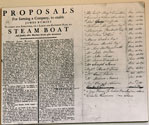
![]() Steamboat Company Proposal and list of members: The Rumseian Society was advertised as a steamboat company. The list of members who purchased shares in it was led by Dr. Franklin. The Society elected William Bingham as its President on May 13, 1788
Steamboat Company Proposal and list of members: The Rumseian Society was advertised as a steamboat company. The list of members who purchased shares in it was led by Dr. Franklin. The Society elected William Bingham as its President on May 13, 1788
Most members were prominent Philadelphia businessmen. The Proposal guaranteed Rumsey half of all interests and profits, the rest to be divided among its membership according to the shares listed.
The papers of the Rumseian Society are housed in the American Philosophical Society Library in Philadelphia. The source of this copy of the proposals is the Washington Papers of the Library of Congress.
Letter of Recommendation: Benjamin Franklin: As Rumsey set out for England within days of the formation of the Rumseian Society, he was given letters of recommendation to aid him in getting established. The one shown here from Dr. Franklin was typical of those of the period. It is copied from a copy in the Library of Congress. Dr. Benjamin Rush, America’s most prominent physician, also wrote Rumsey a letter to his friend in London Dr. John Coakley Lettsom. Rush asked Lettsom to introduce Rumsey’s ideas to James Watt’s partner Bolton and assure Bolton that John Fitch merely copied Rumsey’s ideas. Rush goes on to say: “Mr. Rumsey possess a very uncommon genius… His modesty is equal to his talents for invention. In behalf of his friends (who are among the worthiest citizens) I write to you in his favor. We look up to you to protect genius, to detect and defeat fraud and to reward industry and integrity in a country which has exhibited so many shining examples of them all in the promotion of science.” This letter is quoted in full by local historian John Moray in his 1910 pamphlet: A Brief Account of Last Century’s Inventive Steam Pirate. A copy of this pamphlet is in the Museum’s Rumsey file.
John Vaughn, whose father was alleged to be one of the Rumseian Society, wrote to his brother Benjamin in London about Rumsey’s inventions. He claimed to not be familiar enough to judge between Fitch and Rumsey’s claims but does assert: “I am led to think the most ingenious and material discovery is the boiler, made use of by Mr. Rumsey, which is constructed upon simple, easy and economical principles and of which the invention does not seem to be much contested as in that of the application to navigation of boats. It is upon a supposition the boiler may be applied with great advantage in the numerous steam engines erected with you and that his ingenuity will be patronized and rewarded that Mr. Rumsey goes to England and his voyage is hastened by a fear that some persons taking advantage of his openness may arrogate to themselves the advantages he expects from his discovery.” Vaughn goes on to urge support of Rumsey and his mill inventions as well. He informs his brother that Rumsey also bears letters from Franklin and William Bingham. Vaughn’s letter in copied in the Museum file.
In 1792, this same John Vaughn negotiated with Joseph Barnes to have one of Rumsey’s new mills built for another brother, Charles, in Connecticut. (see P8 Manual.)
Later Rumseian Societies: Several times during the 20th century interest has been revived in this area in Rumsey and new Rumseian Societies (with varying spellings) formed.
In 1906, the first was established in Shepherdstown on February 26. Several of its members were Rumsey enthusiasts and writers of articles about him, (see Museum file) including George Beltzhoover, and Judge Daniel Lucas. The object of the Society was to erect a Rumsey Memorial. The Legislature of West Virginia appropriated a sum of $6,750 for the Memorial. The Monument was erected in 1915 and stands today along the banks of the Potomac outside Shepherdstown where Rumsey held his successful boat trial in 1787.
On January 17, 1937 the Town of Bath Rumseian Society was incorporated. Its charter is currently housed in the collection of Fred Newbraugh. Its members included Anita Buchanan Speer, SS Buzzerd, Frances Ellis Hergesheimer, Ernest L. Johnson, C.P. Ambrose, and Katherine Hunter. Much of their effort was aimed at establishing Port James Rumsey along the Potomac at Sir Johns Run where Rumsey built his first steamboat. (See P3 Manual)
The most recent Rumseian Society was formed again in Shepherdstown in 1985 with several purposes including construction of a working model of Rumsey’s steamboat for exhibition during the bicentennial of Rumsey’s first successful public trial of his boat in 1787.
Rumseian Society logo: The drawing used in the exhibit is the current Rumseian Society logo drawn by Jay Hurley of Shepherdstown. Owner of O’Hurley’s General Store, Mr. Hurley is the main proponent and engineer working on the construction of a working model of Rumsey’s boat. The drawing in the logo is modeled after the boat Rumsey demonstrated in 1787.

![]() Rumsey’s death: The exhibited letter by John Brown Cutting, an American in London who immediately notified then Secretary of State Thomas Jefferson of the inventor’s death, gives an excellent explanation of the circumstances. This letter is contained in the Jefferson Papers, Library of Congress. There were several other letters sent to America immediately including one from R. C. Wakefield on December 26, 1792 to Rumsey’s young artist friend George William West.
Rumsey’s death: The exhibited letter by John Brown Cutting, an American in London who immediately notified then Secretary of State Thomas Jefferson of the inventor’s death, gives an excellent explanation of the circumstances. This letter is contained in the Jefferson Papers, Library of Congress. There were several other letters sent to America immediately including one from R. C. Wakefield on December 26, 1792 to Rumsey’s young artist friend George William West.
A third letter was sent by R. Claiborne to Miers Fisher and the Rumseian Society on January 2, 1793. It is housed in the Rumsey Papers of the Library of Congress.
Rumsey was buried at St. Margaret’s Westminster.
After his death, Joseph Barnes came to England to settle the estate. Rumsey never knew that his other brother-in-law, Charles Morrow preceded him in death by one month.
According to papers filed in a lawsuit brought by partner Dr. James McMechen against Rumsey’s estate in 1801, Rumsey’s inventions sold in England after his death for 7500 pounds sterling. Rumsey’s defense claims that Rumsey died in debt and that profit from the steamboat venture was 1800 pounds sterling or 2400 pounds currency. (see Museum file for copy of McMechen papers.)
Two months after his death, Rumsey’s boat, The Columbia Maid, was reported to have had a successful trial on the Thames. It is not known whether Barnes was present for this trial.
By the 1830’s and 40’s, Rumsey relatives were petitioning Congress for grants to Rumsey’s children in recognition of his inventive contributions. A gold medal was eventually awarded.
click on image to view each section of manual
|
Panels 1 and 2 |
Panels 3 and 4 |
|
Rumsey’s Work In and Around Bath |
Inventions and Patents |

